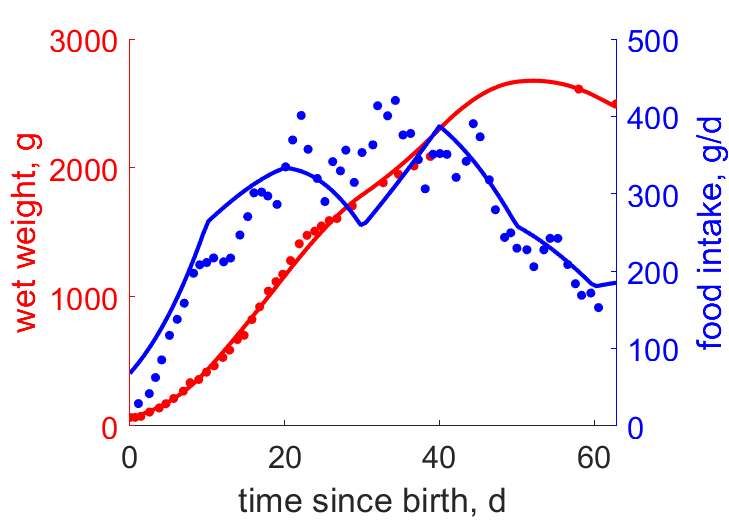Predictions & Data for this entry
| Model: std | climate: Af, Cf | migrate: Ms | phylum: |
| COMPLETE = 2.8 | ecozone: THn, TN | food: biCvf | class: |
| MRE = 0.024 | habitat: 0iTf | gender: Dg | order: |
| SMSE = 0.002 | embryo: Tnpfm | reprod: O | family: |
Zero-variate data
| Data | Observed | Predicted | (RE) | Unit | Description | Reference |
|---|---|---|---|---|---|---|
| ab | 30 | 31.78 | (0.05938) | d | age at birth | AnAge |
| tx | 62 | 61.94 | (0.000982) | d | time since birth at fledging | Kahl1962 |
| tp | 186 | 182.7 | (0.01786) | d | time since birth at puberty | guess |
| tR | 1460 | 1460 | ( 0) | d | time since birth at 1st brood | AnAge |
| am | 9855 | 9790 | (0.006613) | d | life span | AnAge |
| Ww0 | 80 | 78.3 | (0.02125) | g | initial wet weight | avibase |
| Wwb | 62 | 61.46 | (0.008694) | g | wet weight at birth | AnAge |
| Wwi | 2115 | 2174 | (0.02804) | g | ultimate wet weight | avibase |
| Wwim | 2640 | 2651 | (0.004001) | g | ultimate wet weight of males | avibase |
| Ri | 0.008219 | 0.008148 | (0.008697) | #/d | maximum reprod rate | AnAge, avibase |
Uni- and bivariate data
| Data | Figure | Independent variable | Dependent variable | (RE) | Reference |
|---|---|---|---|---|---|
| tWJX |   | time since birth | wet weight food intake | (0.1049) | Kahl1962 |
Pseudo-data at Tref = 20°C
| Data | Generalised animal | Mycteria americana | Unit | Description |
|---|---|---|---|---|
| v | 0.02 | 0.0345 | cm/d | energy conductance |
| p_M | 18 | 499 | J/d.cm^3 | vol-spec som maint |
| k_J | 0.002 | 0.02035 | 1/d | maturity maint rate coefficient |
| k | 0.3 | 0.2987 | - | maintenance ratio |
| kap | 0.8 | 0.9536 | - | allocation fraction to soma |
| kap_G | 0.8 | 0.7996 | - | growth efficiency |
| kap_R | 0.95 | 0.95 | - | reproduction efficiency |
Discussion
- Body temperatures are guessed
- scaled functional response varies
- males are assumed to differ from females by {p_Am} only
- tW data is inconsistent with tJX data after day 30; additional food intake must have occured
- mod_1: v is reduced
- mod_2: Pseudo-data point k is used, rather than k_J; Data set tp and parameter t_R are added, the latter replacing clutch interval t_N. Postnatal T is based on PrinPres1991, see get_T_Aves. See further the revision page, theme puberty
Bibliography